
Riich 1/200 USS Harder
| KIT #: | RS20002 |
| PRICE: | $52.00 SRP |
| DECALS: | One option plus two for the OS2Us |
| REVIEWER: | Tom Cleaver |
| NOTES: | USS Gato kit modeled as USS Harder |

| HISTORY |
USS Harder
(SS-257 was the 45th of 77 Gato class fleet submarines built during
the Second World War. Her keel was
laid at the Electric Boat yards in New London Connecticut the Monday before the
Pearl Harbor attack, and she was launched on August 19, 1942, being commissioned
December 2, a year and a day after her keel was laid.
Her one and only commander was Sam Dealey, scion of a prominent family in
Texas (Dealey Plaza, where President John Kennedy was assassinated, was named
for his grandfather, the founder of the Dallas Morning News).
An undistinguished graduate of the Class of 1930 from Annapolis, Dealey
went into submarines in the late 1930s, and had commanded two S-class submarines
by the time he was named Prospective Commanding Officer of Harder in the spring
of 1942. Harder distinguished
herself on all her patrols, with Dealey being awarded no less than four Navy
Crosses in recognition of his crew’s achievements, topping that by being the
third submarine commander of the war awarded to Medal of Honor.
Harder would be the fifth-ranked U.S. submarine of the war with 16 enemy
ships claimed for 54,000 tons.
The Epic Fifth War Patrol of
USS Harder:
The invasion of
the Marianas was the most important event to date in the Pacific War. With the
Marianas under American control, air bases could be built that would put the new
B-29 Superfortress in range of the Japanese homeland.
The Japanese were equally aware of the result if they lost these islands,
which guaranteed a maximum defensive effort by the Imperial Navy as the
Americans penetrated the inner perimeter of Japan’s Pacific empire. There was no
way a major fleet action would not
happen and everyone involved knew it.
As the ships of
Task Force 58 headed for their rendezvous with destiny in the Marianas, one of
the greatest submarine battles of the Pacific War, an action that would have a
momentous effect on the coming fleet action off the Marianas, was shaping up at
Tawi-Tawi, the southern Philippines anchorage of Kido Butai. It was the
fifth war patrol of the submarine USS Harder (SS-257), an action since
labeled by historians as the most important U.S. submarine patrol of the Pacific
War.
As it became
clear to the leaders of the Imperial Navy that the next American goal must be
the Marianas, Kido Butai (Combined Fleet) Commander Admiral Soemu Toyoda
began gathering the disparate combat elements of his fleet at Tawi-Tawi
beginning in mid-May. Admiral
Jisaburo Ozawa brought the carrier striking force from the Lingga Roads in
Singapore. The heart of the force
was the five heavy carriers: the two veterans Shôkaku and Zuikaku,
participants in the Pearl Harbor attack and the carrier battles at Coral Sea,
the Eastern Solomons and Santa Cruz in 1942; Ozawa’s flagship was the brand-new
carrier Taihô, an improved Shôkaku class with the first armored
flight deck of any Japanese carrier, which had only joined the fleet a bit over
two months earlier; the carriers Junyô and Hiyô which had
participated in the Aleutians strikes; and four light carriers: Ryûhô
(not to be confused with Ryûjô which was sunk at the Battle of Eastern
Solomons in 1942, though such confusion has dogged historians for 60 years),
 Chitose,
Chiyoda, and Zuihô; there were five battleships: Yamato,
Musashi, Kongô, Haruna and Nagato under the command of Vice Admiral
Takeo Kurita. After intensive training operations to make good the aviation
losses incurred at Rabaul and Truk, this was the strongest Japanese fleet in the
war to date, and would carry more aircraft into the coming battle than their
American opponents, though the problem for the Japanese was aircrew quality.
The air battles over the Pacific since the previous October had decimated
what was left of the veteran pilots and aircrews of the IJNAF and many of their
replacements were barely able to land and take off from an aircraft carrier, let
alone engage in air combat.
Chitose,
Chiyoda, and Zuihô; there were five battleships: Yamato,
Musashi, Kongô, Haruna and Nagato under the command of Vice Admiral
Takeo Kurita. After intensive training operations to make good the aviation
losses incurred at Rabaul and Truk, this was the strongest Japanese fleet in the
war to date, and would carry more aircraft into the coming battle than their
American opponents, though the problem for the Japanese was aircrew quality.
The air battles over the Pacific since the previous October had decimated
what was left of the veteran pilots and aircrews of the IJNAF and many of their
replacements were barely able to land and take off from an aircraft carrier, let
alone engage in air combat.
The fleet put
into Tawi-Tawi on May 23, 1944, to prepare for Operation A-Go, the coming
action to pin the American carriers against the Marianas Islands and attack with
shuttle flights from the carriers to bases in the Marianas and then again on the
return flights, while the fact the
American invasion forces were ashore forced the American fleet to maintain its
position.
On May 27, the Japanese plans were thrown into
disarray by the American invasion of Biak Island, north of New Guinea.
Admiral Toyoda saw this as the American attack he must oppose and
prepared to set sail. Before
Kido Butai could set sail, however, a Japanese reconnaissance flight to the
Marshall Islands found Task Force 58 in the Majuro anchorage.
The Japanese were at a loss; was this fleet to support the invasion that
had just happened, or to participate in the expected Marianas invasion?
Most Japanese staff officers thought it impossible the Americans could
mount what was seen as two major invasions simultaneously, an indication of how
little they understood the nature of their enemy.
The fact that the recon flight did not spot American carriers at Majuro
led Admiral Toyoda to decide the Biak invasion was the main enemy attack and he
began planning his sortie accordingly.
Events were about to become even more confusing for the Admiral.
Unknown to Admiral Toyoda, USS Harder
(SS-257), under the command of Commander Sam Dealey - one of the five most
successful American submarine commanders of the Pacific War, known as “a
submariner’s submariner” - had departed the American submarine base at
Fremantle, Australia on her fifth war patrol three days after Ozawa’s fleet
arrived at Tawi-Tawi, accompanied by USS Redfin (SS-272).
Dealey’s orders were to patrol the Japanese anchorage at Tawi-Tawi to see
what was there while Redfin operated in the Celebes Sea. He arrived of
Tawi-Tawi on the day Task Force 58 departed Majuro for the Marianas.
Harder was not unknown to the aviators of Task Force 58.
During her fourth war patrol, she was assigned as the lifeguard submarine
covering the strikes by Task Force 58 against the island of Woleai in the
western Caroline Islands on April 1, 1944.
Notified that an American aviator, Ensign John Galvin of Fighting 8
aboard USS Bunker Hill, had been shot down and was in a raft just off the
island, Dealey brought Harder in on the surface under air cover. Galvin,
who was injured from the bailout and exhausted from being buffeted by the
merciless sea, had been driven inside the reef and close to shore by the winds
and waves and ended up on the beach, where he passed out.
Awakened by a low-flying American plane that dropped him a message,
Galvin looked out and saw Harder approaching beyond the reef.
Spotting the downed airman ashore, Dealey approached slowly and
cautiously to put Harder aground against the reef bow on, holding
position with the screws in a masterful display of seamanship under Japanese
fire while torpedo officer Lt. Sam Logan, Machinist Francis X. Logan, and Seaman
J.W. Thomason made their way across the reef through the thundering surf in a
rubber boat to make the rescue. An aircraft dropped a raft to Galvin, who
inflated it and got back into the water; he and his exhausted rescuers were
finally united as the air cover strafed the Japanese ashore.
Dealey himself suffered a near-miss that parted his hair, fired by one
sniper ashore. A Curtiss SOC-3 Seagull float plane then landed in the lagoon and
taxied over the line that linked the raft to the submarine.
Thomason swam 800 yards through the heavy surf to bring the line to the
submarine so the others could be hauled back. After a two hour ordeal Galvin and
his rescuers were finally hauled aboard.
Harder’s rescue was now legendary throughout the fleet.
As the carriers of Task Force 58 secured from
General Quarters with nightfall on June 6, their first day at sea, Harder
entered the Sibutu Passage outside Tawi-Tawi.
Just after 2230, she discovered a convoy of three tankers and two
destroyers, one of which – IJN Minatsuki - detected the surfaced
submarine in the bright moonlight and initiated a pursuit. Diving to periscope
depth, Dealey held his position against the charging destroyer.
During the previous patrol he had perfected the maneuver of holding
position submerged against an attacking destroyer and torpedoing the enemy ship
with a “down the throat” shot at minimum range.
Dealey allowed Minatsuki to close to a distance under 1,100 yards
before firing three torpedoes. The
first two missed to either side, while the third was a solid hit. Minatsuki
exploded and sank with all hands.
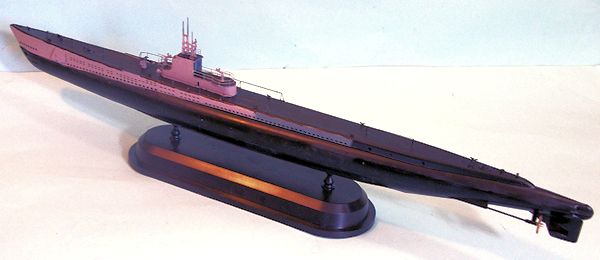 Taking Harder deep to avoid a fierce depth
charge attack from the second destroyer, Dealey evaded and surfaced shortly
after midnight on June 7. Within
nine minutes, lookouts spotted the destroyer Hayanami south of Tawi Tawi.
Another spread of three torpedoes resulted in a second destroyer kill.
After being depth-charged for several hours by eight destroyers hunting the
submarine, Harder departed the area, headed for northern Borneo to pick
up a group of eight Australian special forces commandos in danger of being
captured. The morning report of two destroyer losses overnight right outside the
harbor led Admiral Toyoda to fear that an American submarine wolf pack might be
operating outside the fleet’s anchorage.
Taking Harder deep to avoid a fierce depth
charge attack from the second destroyer, Dealey evaded and surfaced shortly
after midnight on June 7. Within
nine minutes, lookouts spotted the destroyer Hayanami south of Tawi Tawi.
Another spread of three torpedoes resulted in a second destroyer kill.
After being depth-charged for several hours by eight destroyers hunting the
submarine, Harder departed the area, headed for northern Borneo to pick
up a group of eight Australian special forces commandos in danger of being
captured. The morning report of two destroyer losses overnight right outside the
harbor led Admiral Toyoda to fear that an American submarine wolf pack might be
operating outside the fleet’s anchorage.
After picking up the commandos on June 8, Harder
returned to Tawi-Tawi and on the night of June 9 the submarine was in the
narrowest part of the Sibutu Passage, six miles outside the mouth of the
Tawi-Tawi anchorage, when Dealey spotted two more patrolling destroyers, one of
which was identified as the Tanikaze.
Submerging only deep enough that the radar remained above the surface,
Harder approached the targets. Dealey fired four torpedoes at the
overlapping targets. As recorded in the log, the action unfolded as follows:
“Commenced firing the bow tubes. No. 1 torpedo appeared to pass just ahead of
the first destroyer, No. 2 struck it near the bow, No. 3 hit just under the
destroyer's bridge, and No. 4 passed astern. The sub was now swung hard right to
avoid hitting the first destroyer and fire was withheld on remaining tubes until
a new setup could be put into the T.D.C. for an attack on the second destroyer.
About thirty seconds after turning, the second destroyer came into view just
astern of what was left of the first one, then burning furiously. Just then No.
4 torpedo which had passed astern of the first target was heard and observed to
hit the second target... Meanwhile, a heavy explosion, believed to be caused by
an exploding boiler on the first destroyer, went off and the sub, then about 400
yards away, was heeled over by the concussion. At almost the same time a
blinding explosion took place on the second destroyer (probably his ammunition
going off) and it took a quick nose dive. When last observed by the Commanding
Officer and Executive Officer, the tail of the second destroyer was straight in
the air and the first destroyer had disappeared. Sound now reported, ‘No more
screws.’ The above listed pandemonium may not be in exact chronological order
but is as accurate as the happenings over that eventful few minutes can be
remembered.”
Japanese sailors aboard the ships of Kido Butai
inside Tawi-Tawi watched the action right outside the harbor with apprehension.
A badly-rattled Admiral Toyoda determined that the fleet must now abandon Tawi
Tawi anchorage as being too exposed to enemy submarines.
On June 10, he decided to oppose the American invasion at Biak and sent
Admiral Matome Ugaki in command of the super-battleships Yamato and
Musashi, accompanied by the battleship Haruna, with the supporting
heavy cruisers Myoko, Haguro and Noshiro and five destroyers, to
attack the Americans in Operation Kon.
That afternoon, Dealey spotted Ugaki’s task force
as it emerged from Tawi-Tawi and moved in to attack.
An escort plane overhead spotted the submarine at periscope depth and a
screening destroyer promptly headed toward Harder at 35 knots. As the
range closed to 1,500 yards, Dealey fired three t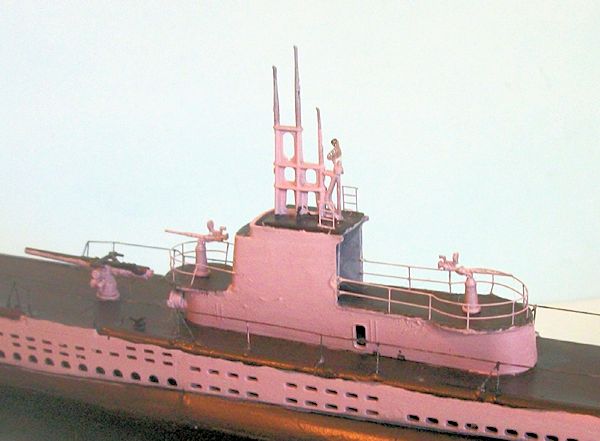 orpedoes
in a "down the throat" shot, then went deep to escape the attacking destroyer.
Within a minute two torpedoes blasted the unidentified ship just as Harder
passed some 80 feet below. The deafening explosions shook her far worse than the
depth charges the infuriated enemy dropped over the next two hours. Surfacing
after dark, Harder found only a lighted buoy marking the spot where the
unidentified destroyer either sank or was heavily damaged. Spotted by another
destroyer, Dealey again let the enemy come at him head on, and fired his last
two torpedoes in a final “down the throat shot.” The zig-zagging attacker evaded
and Harder was forced to “run silent, run deep” while she was subjected
to a fierce depth-charging. At dawn on June 11, Harder entered the Sibutu
Passage submerged and carried out a reconnaissance of the Tawi-Tawi anchorage,
which was now empty. Surfacing a few hours later, Dealey sent his report of the
Japanese fleet’s sortie, then set course for Darwin. The report provided the
first firm knowledge for Admiral Spruance and Task Force 58 that the Japanese
fleet was on its way.
orpedoes
in a "down the throat" shot, then went deep to escape the attacking destroyer.
Within a minute two torpedoes blasted the unidentified ship just as Harder
passed some 80 feet below. The deafening explosions shook her far worse than the
depth charges the infuriated enemy dropped over the next two hours. Surfacing
after dark, Harder found only a lighted buoy marking the spot where the
unidentified destroyer either sank or was heavily damaged. Spotted by another
destroyer, Dealey again let the enemy come at him head on, and fired his last
two torpedoes in a final “down the throat shot.” The zig-zagging attacker evaded
and Harder was forced to “run silent, run deep” while she was subjected
to a fierce depth-charging. At dawn on June 11, Harder entered the Sibutu
Passage submerged and carried out a reconnaissance of the Tawi-Tawi anchorage,
which was now empty. Surfacing a few hours later, Dealey sent his report of the
Japanese fleet’s sortie, then set course for Darwin. The report provided the
first firm knowledge for Admiral Spruance and Task Force 58 that the Japanese
fleet was on its way.
Harder's fifth war
patrol has been called the most brilliant U.S. submarine action of the war, in
light of its results. Dealey’s frequent attacks and the rash of contact reports
generated by these events had so frightened Admiral Toyoda into believing that
Tawi‑Tawi was surrounded by submarines that he ordered Ozawa’s carrier force to
depart at dawn on June 11 in the belief the carriers would be safer at sea.
Hours after Ozawa’s Mobile Fleet cleared the harbor, the news flashed to
Tawi-Tawi that Task Force 58 had arrived off the Marianas at dawn, in position
to begin the assault on the Marianas. Admiral Toyoda realized he had guessed
wrong about American capabilities.
Admiral Ugaki was ordered to turn north with his battleships and rendezvous with
the carriers as Kido Butai formed for battle.
Operation A-Go was now in effect.
As a result of having been ordered to leave Tawi‑Tawi a day ahead of
schedule, Admiral Ozawa was now forced to wait in the Philippine Sea until Ugaki
could join up, and his carrier force was tracked by other U.S. submarines with
eventual deadly results. Dealey’s
actions were thus a major contribution to the stunning defeat the Japanese would
suffer in the coming Battle of the Philippine Sea.
Harder had
inflicted a defeat on the Japanese of such strategic importance that Sam Dealey
became the third American submarine commander to be recognized with the award of
the Medal of Honor (posthumously in his case, Harder being sunk on her
next patrol). After the war, Harder’s claims for destroyers sunk on this patrol
was reduced by two when comparing claims to Japanese loss records - the
destroyer sunk along with Tanikaze and the destroyer sunk while
attempting to attack Ugaki’s task force. Four destroyers sunk in one patrol was
still the American record. She had
certainly lived up to her motto: “Hit ‘Em Harder”.
American submarines would go on to inflict the most
important losses on the Japanese fleet in the Battle of the Philippine Sea, when
on the morning of June 19 as the Mobile Fleet
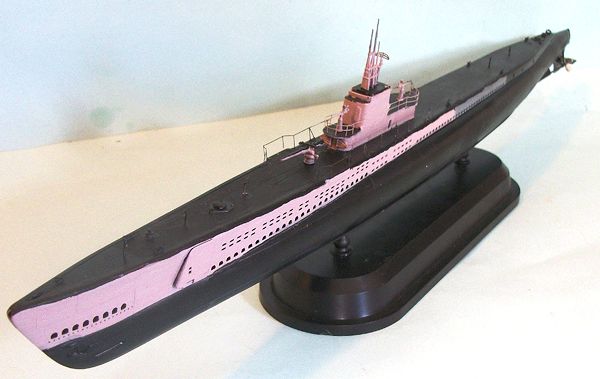 launched
the first strike of what would come to be known as “The Marianas Turkey Shoot,”
the veteran USS Albacore torpedoed the brand new carrier Taiho,
while the newcomer USS Cavalla torpedoed the Pearl Harbor veteran
Shôkaku. Both ships sank later
that day with major loss of life at great shock to the rest of the fleet.
launched
the first strike of what would come to be known as “The Marianas Turkey Shoot,”
the veteran USS Albacore torpedoed the brand new carrier Taiho,
while the newcomer USS Cavalla torpedoed the Pearl Harbor veteran
Shôkaku. Both ships sank later
that day with major loss of life at great shock to the rest of the fleet.
Sadly, on her next patrol, Harder would be sunk with the loss of all hands off the west coast of Luzon by Patrol Boat No. 102. Ironically, this was the ex-USS Stewart (DD-224), which had been abandoned in dry dock in Surabaya March 1,1942; she was later raised and repaired by the Japanese and returned to service in September 1943.
| THE KIT |
U.S. Fleet Submarines are now popular.
Trumpeter was first off with a 1/144 USS Gato back in 2007, which was
followed in 2008 by Revell’s enormous 1/72 Gato boat.
AFV has released fleet boats in all operational configurations in 1/350
which are among the best submarine kits available.
This new kit from Riich Models in China is their second in 1/200.
The scale results in a model that is significantly smaller than the
Trumpeter kit, which is big in 1/144 (fleet boats were the biggest submarines of
their generation). Being larger
than the 1/350 kits it provides more visible detail.
This is the late war configuration Gato with additional surface armament:
two nice 20mm cannons and an early 4‑inch 50‑caliber deck gun.
With the limber holes in the forward separate sections of the hull, this
kit can be used to do any Electric Boat-built Gato; with the separate pieces, it
may be that we will see Mare Island or Portsmouth boats, or even Balao or
Tench class submarines.
The kit is well‑molded in light grey plastic with
sharp surface detail. Being 1/200,
it doesn’t need a lot of photo‑etch parts, other than to use the photo‑etch
railings in place of plastic parts that require thread to finish off.
| CONSTRUCTION |
Being in the middle of reading Michael Sturma’s
excellent “Death At A Distance: The Loss of the Legendary USS Harder” and
having been a fan of Harder ever since reading Edward L. Beach’s
excellent history “Submarine” in my youth, I decided I wanted to do USS
Harder (SS-257). This was
aided by the fact that Harder was also built at Electric Boat and thus
had the same limber holes as Gato (I’m not crazy enough to fill all those holes
and do my own limber holes)
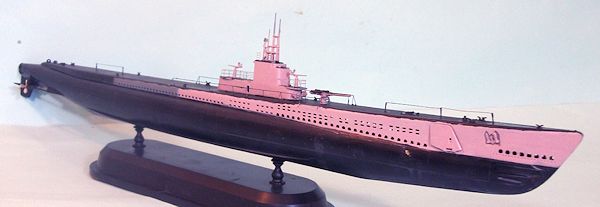 As with all submarine kits, construction is not
difficult as there are not a lot of parts.
What’s there fits nicely, though it does take a bit of effort to mate the
upper hull assembly to the lower hull.
The kit is designed this way for those who want to build a waterline
model. I had to use cyanoacrylate
glue and a couple of sanding sessions to get the hull joint smooth.
Other than that, there were no problems.
As with all submarine kits, construction is not
difficult as there are not a lot of parts.
What’s there fits nicely, though it does take a bit of effort to mate the
upper hull assembly to the lower hull.
The kit is designed this way for those who want to build a waterline
model. I had to use cyanoacrylate
glue and a couple of sanding sessions to get the hull joint smooth.
Other than that, there were no problems.
The hardest part was the photoetch railings.
They are very thin and very fragile; I attached them with Gator Glue, but
if I do another one I think I might use the plastic stanchions and stretched
sprue option provided in the kit.
The main visual difference between Harder
and Gato was that Harder’s SJ radar antenna was moved behind the
periscope array during her overhaul at Mare Island.
This was easily accomplished since the SJ antenna mast is separate in the
kit. I used a Tom’s Model Works photoetch antenna screen.
| COLORS & MARKINGS |
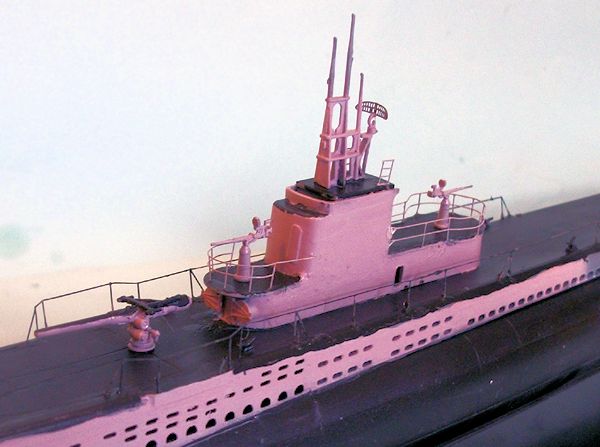 Harder, like all other US Fleet Submarines, was originally painted
in Measure 9 camouflage, which was overall black upper surfaces.
This was actually a gloss paint, as were all submarine paints, since
these are less likely to corrode underwater.
At the outset of her third patrol from Midway in the summer of 1943, she
received a repaint of dark grey.
When Harder went back to Mare Island at the conclusion of her third
patrol to have her troublesome diesel engines replaced and a full overhaul, she
received the Measure 32/3SS-B scheme, known as “the light grey job.” During
exercises with USS Seahorse during the first 10 days outbound from Pearl
Harbor on her fourth patrol, Sam Dealey became convinced that using a “pink” hue
on the lighter grey section of the camouflage would be more effective,
particularly at the important times of dawn and dusk (this is the same concept
that led to the “pink” Spitfire F.R. IX)
When Harder departed Fremantle on her fifth patrol, witnesses
stated that she wore a “pinkish” color in place of the light grey.
I created that color by mixing some “pink” and then mixing it with Tamiya
“Light Grey” XF-66. The rest of the
model was painted following the rules of Measure 32/3SS-B.
Harder, like all other US Fleet Submarines, was originally painted
in Measure 9 camouflage, which was overall black upper surfaces.
This was actually a gloss paint, as were all submarine paints, since
these are less likely to corrode underwater.
At the outset of her third patrol from Midway in the summer of 1943, she
received a repaint of dark grey.
When Harder went back to Mare Island at the conclusion of her third
patrol to have her troublesome diesel engines replaced and a full overhaul, she
received the Measure 32/3SS-B scheme, known as “the light grey job.” During
exercises with USS Seahorse during the first 10 days outbound from Pearl
Harbor on her fourth patrol, Sam Dealey became convinced that using a “pink” hue
on the lighter grey section of the camouflage would be more effective,
particularly at the important times of dawn and dusk (this is the same concept
that led to the “pink” Spitfire F.R. IX)
When Harder departed Fremantle on her fifth patrol, witnesses
stated that she wore a “pinkish” color in place of the light grey.
I created that color by mixing some “pink” and then mixing it with Tamiya
“Light Grey” XF-66. The rest of the
model was painted following the rules of Measure 32/3SS-B.
I gave the model an overall coat of Xtracrylix
Satin varnish with a bit of Flat mixed in, to give the glossy finish of a fleet
boat. I then attached the conning
tower, and then the delicate photo etch railings, and finally the deck gun and
20mm cannon.
| CONCLUSIONS |
A really good kit, in a size that allows good
detail without creating space problems for later storage.
Did I mention it’s a real “pink(ish) submarine”??
Highly recommended.
Review kit courtesy of your editor and www.dragonmodelsusa.com
If you would like your product reviewed fairly and fairly quickly, please contact the editor or see other details in the Note to Contributors.